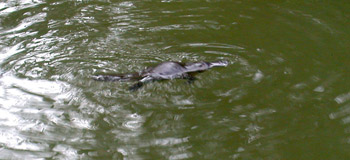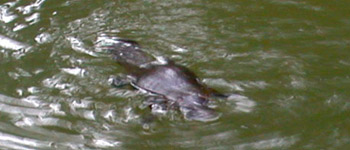July
4, 2004
Mackay Harbour Marina, Queensland
Crocs and Critters, , Part III
By Lois Joy
![]()
This series is dedicated to Cody, Brett, Manuel, Trey, Kaitlyn, Leone and all of the children who read our website; Part III tells about our tour to Broken River—on American Independence Day—where we were lucky to see our first platypus.
We left the marina on a tour van. The van driver took us far into the hinterlands through Pioneer Valley and up into the mountains. We hiked 2 miles up to a waterfall. It was hard but the way back down was easy. We had lunch at a Chalet overlooking the valley far below. Then we drove to Broken River. It was a cloudy day and late in the afternoon—good conditions for sighting a platypus.
 First
we went on the bridge crossing the river. All I saw were three turtles; I
called them ‘bumps on a log.’ One turtle had another one on his
back, hitching a free ride. We waited, but a platypus did not come. So then
we walked to a viewing platform a ways down the river. Before long, we saw
one swimming in our direction. We were very lucky. Many times, visitors take
this trip and do not see one. In fact, not many people in the world have seen
a platypus in the wild. They are very shy and like to come out only at dusk
or during the night. They are common only in rivers and streams in Eastern
Australia.
First
we went on the bridge crossing the river. All I saw were three turtles; I
called them ‘bumps on a log.’ One turtle had another one on his
back, hitching a free ride. We waited, but a platypus did not come. So then
we walked to a viewing platform a ways down the river. Before long, we saw
one swimming in our direction. We were very lucky. Many times, visitors take
this trip and do not see one. In fact, not many people in the world have seen
a platypus in the wild. They are very shy and like to come out only at dusk
or during the night. They are common only in rivers and streams in Eastern
Australia.
Gunter video taped the platypus as he dived under the water
to catch food, then surfaced to the top. They cannot finish eating their food
under water. My camera didn’t take as good still photos, but I put some
here for you anyway. The bill, feet and fur of the platypus are made for living
in the water. We loved watching it dive down into the muddy river, then paddle
to the top, over and over again. The bubbles in the water would show where
he was.
Here is a science lesson for you: The platypus is a neither a reptile or a mammal; it is a monotreme. It lays eggs, as reptiles do, but the mother also feeds its young on milk that is secreted through her skin from mammary glands. Its genes, skeleton, and reproductive system are like that of a mammal.
Is a platypus dangerous? Well, you know, Australia has more
things that can kill you than anyplace else in the world. So don’t be
surprised: The males have an unusual poison spur on the hind legs and the
toxin can cause serious tissue damage. So they are not something you would
want to handle or pet!
Back to Crocs and Critters, Part II











